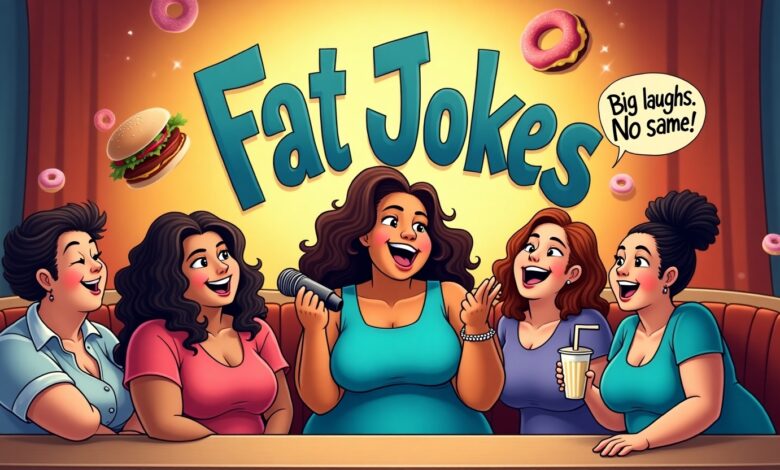Understanding Fat Jokes — The Laughter That Cuts Both Ways

Fat Jokes. 1Humour has always been a reflection of society. The jokes people tell reveal not only what they find funny but also what they feel comfortable mocking. Among the most enduring and controversial are fat jokes. On the surface, they may seem harmless — a quick laugh, a silly quip, or an exaggerated cartoon. But underneath, they often carry a heavy weight of stigma, shame, and cultural bias.
So what exactly are fat jokes? They are jokes that target body size, usually through stereotypes or exaggerated depictions of eating, laziness, or physical awkwardness. These jokes often rely on visual gags, exaggerated sound effects, or verbal punchlines that reduce people to their bodies. To the Joker, they may feel playful or even “edgy.” To the audience, they may spark laughter. But to the person on the receiving end, the effect is far more complicated.
Fat jokes are not just about humour; they are about social power. They expose how societies view body weight and how humour is used to normalise ridicule. Understanding them requires us to dig into history, culture, psychology, and ethics — because laughter, while universal, is never neutral.
The Historical Roots of Fat Jokes
Fat jokes didn’t emerge overnight. They are rooted in centuries of cultural storytelling and visual caricature. In medieval plays, the “glutton” character often wore padding and was mocked for greed and slowness. In Victorian cartoons, plumpness was exaggerated into grotesque forms, often to symbolise moral weakness. These depictions turned fatness into shorthand for lack of discipline, making mockery seem natural.
As mass media developed, these tropes persisted. Silent films often featured overweight characters as comic relief — slipping on banana peels, breaking furniture, or getting stuck in doorways. Animated cartoons used roundness as an instant symbol of clumsiness. By the time television sitcoms took off, the “fat character” became a predictable archetype: the goofy sidekick, the bumbling dad, or the target of endless teasing.
What this history shows is that fat jokes have been less about individual humour and more about cultural narrative. They reinforce an assumption: fatness equals excess, laziness, or incompetence. When repeated for generations, such portrayals stop being jokes and become embedded beliefs.
Why People Tell Fat Jokes
The persistence of fat jokes comes down to a mix of psychology, social dynamics, and cultural reinforcement. People tell these jokes for many reasons:
- To feel superior. Mocking someone’s body is an easy way to establish dominance. The Joker positions themselves as “better,” reinforcing hierarchies.
- To bond socially. Shared laughter builds connection. Unfortunately, that bonding often comes at the expense of someone else’s dignity.
- For shock value. In comedy, crossing taboos can feel powerful. Fat jokes allow comedians to provoke without needing complex setups.
- Because of internalised stigma. Some individuals joke about their own weight as a defence mechanism. By laughing first, they reduce the sting of potential insults.
- Through normalisation. Many people repeat fat jokes simply because they’ve heard them so often. Without reflection, they become part of casual conversation.
The motivations may differ, but the outcome is similar: reinforcing the idea that fatness is inherently funny. And that reinforcement shapes not just individual interactions but cultural norms.
The Harm Behind Fat Jokes
It’s tempting to dismiss fat jokes as harmless fun. But research, as well as lived experience, tells a different story. The harm they cause can be profound and long-lasting.
Psychological and Emotional Consequences
Being the butt of a fat joke can chip away at self-esteem. For children and teens, it may lead to social withdrawal, eating disorders, or long-term body dissatisfaction. For adults, it can trigger anxiety, shame, or depression. The emotional impact is often compounded by the social pressure to laugh along, creating a cycle where victims feel silenced.
Social and Structural Damage
Fat jokes don’t exist in isolation. They reinforce anti-fat bias — prejudice that influences hiring decisions, medical treatment, and social inclusion. When the media portrays fat bodies as laughable, it gives society permission to treat them as less valuable. That bias contributes to systemic discrimination in workplaces, schools, and even healthcare.
Internalized Stigma
Over time, individuals who are constantly subjected to fat jokes may begin to believe the stereotypes themselves. This internalised stigma can discourage healthy behaviours, limit social participation, and create a negative feedback loop where shame becomes normalised.
The reality is that fat jokes aren’t “just jokes.” They’re part of a broader cultural system that marginalises people based on their bodies.
When Humour Crosses the Line
Not all jokes about weight are automatically cruel. Humour is complex, and context matters. But there are clear signs of when fat jokes cross ethical boundaries:
- When the punchline is the body itself, not behaviour or circumstance.
- When the joke reinforces harmful stereotypes about laziness, greed, or incompetence.
- When the power imbalance means the target has no way to respond safely.
- When the intent may be playful, but the impact is harmful.
The concept of “punching up vs. punching down” is helpful here. Comedy that challenges institutions or cultural norms can be empowering. Comedy that ridicules marginalised individuals is usually destructive.
That doesn’t mean humour around body image is off limits. But it requires creativity. Jokes that critique unrealistic beauty standards, expose the absurdity of diet culture, or highlight the hypocrisy of media portrayals can spark laughter without reinforcing stigma.
Fat Jokes in Media and Pop Culture
Fat jokes have been a staple of television, film, and stand-up comedy for decades. In older sitcoms, the “fat best friend” or “bumbling father” was almost guaranteed. Animated shows frequently use characters’ size as a running gag. Even in children’s media, weight was often shorthand for laziness or greed.
But the landscape is shifting. With growing awareness of body positivity and inclusivity, audiences are more critical of lazy stereotypes. Comedians and writers who rely on fat jokes face pushback. Social media amplifies this criticism, making it harder for fat jokes to go unchallenged.
Still, they haven’t disappeared. Memes, GIFs, and viral clips often use body size as quick humour. The challenge now is balancing comedic freedom with cultural responsibility — a balance that requires intentionality and empathy.
How Writers and Creators Can Approach Humour Responsibly
For those creating content, the question becomes: how do you handle humour around body size without reinforcing harmful tropes? Here are some guidelines:
- Focus on systems, not bodies: Mock diet fads, unrealistic media portrayals, or cultural obsessions with thinness rather than individuals.
- Use irony and inversion: Flip stereotypes on their head. For example: “They told me to lose weight, so I lost their phone number.”
- Balance with humanity: If you write a fat character, give them depth beyond weight. Their humour should come from wit, personality, or circumstance, not size.
- Test your material. Ask: Would this joke be funny if told about me? If the answer is no, reconsider.
Comedy doesn’t have to be cruel to be clever. The best humour is creative, layered, and thought-provoking.
Reactions and Resistance
Not everyone accepts fat jokes quietly. Activists, writers, and comedians are increasingly vocal in calling out body-shaming humour. Movements like fat acceptance and body positivity highlight how damaging these jokes are and encourage alternative narratives.
Online, communities of fat individuals push back against ridicule, reclaiming language and sharing stories that counter stereotypes. Some comedians intentionally subvert fat jokes, turning them into a satire of the stigma itself.
Resistance matters because it shows that humour can evolve. By rejecting lazy stereotypes, audiences create space for smarter, kinder comedy.
Real-Life Experiences
Hearing real stories reveals the human impact of fat jokes.
A woman recalls her classmates chanting “fatty” during gym class. Even years later, the memory shapes how she views exercise and public spaces. Another person describes co-workers joking about their lunch choices, leaving them embarrassed to eat in front of others. Online, countless individuals describe scrolling past memes that mock bodies, feeling invisible or ridiculed.
These experiences remind us that laughter has consequences. What feels lighthearted to one person can feel crushing to another. Humour that excludes leaves scars, even if no harm was “intended.”
FAQs About Fat Jokes
Q: Are fat jokes ever harmless?
A: Context matters, but repeated mockery of body size is rarely harmless. Jokes that critique cultural norms, not bodies, are safer.
Q: If someone laughs at a fat joke about themselves, is it okay?
A: Not necessarily. People may laugh out of discomfort or pressure. That doesn’t mean the joke was harmless.
Q: Can fat jokes motivate people to lose weight?
A: Evidence suggests the opposite. Stigma often leads to shame and unhealthy behaviours rather than positive change.
Q: How should I respond if a friend tells a fat joke?
A: Gently challenge it: “That one doesn’t sit right with me.” Redirecting the conversation can spark reflection without hostility.
Q: Do fat jokes still exist in modern comedy?
A: Yes, but audiences are increasingly critical. Writers and performers who rely on them risk backlash and irrelevance.
Conclusion — Toward Better Humour
Fat jokes are more than quick laughs; they are cultural signals about who is acceptable and who is not. They reveal deep biases that shape how people are treated in schools, workplaces, media, and even friendships.
But humour is flexible. It evolves with society. We can create laughter that is inclusive, clever, and thought-provoking without tearing others down. By questioning fat jokes, we open the door to comedy that challenges power, mocks hypocrisy, and brings people together instead of dividing them.

